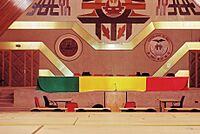National Assembly (Mali) facts for kids
Quick facts for kids National AssemblyBambara: Depitebulon |
|
|---|---|
 |
|
| Type | |
| Type | |
|
Term limits
|
5 years |
| Seats | 147 deputies |
| Elections | |
| Two-round voting | |
|
Last election
|
2020 |
|
Next election
|
2023 |
| Meeting place | |
 |
|
| Bamako, Mali | |
The National Assembly of Mali (Bambara: Mali depitebulon) is like the country's main law-making group. It has 147 members who help run the country. This group is called a unicameral body. This means it has only one main chamber or house.
Contents
How Members Are Chosen
The people who work in the National Assembly are called deputies. Citizens vote directly for these deputies. This is called universal suffrage, meaning everyone eligible can vote.
Elections and Terms
Deputies are chosen for a five-year term. This means they serve for five years before new elections are held. During their time, they have special protection called parliamentary immunity. This helps them do their job without fear.
Voting System
Deputies are elected from different areas, called single-member districts. To win, a candidate needs more than half of the votes. This is part of a two-round voting system. If no one wins in the first round, the top candidates go to a second vote.
When the Assembly Meets
The National Assembly usually meets twice a year.
- One meeting starts on the first Monday in October. It lasts for up to 75 days.
- The other meeting starts on the first Monday in April. It lasts for up to 90 days.
Special Meetings
Sometimes, extra meetings can be called. The Prime Minister can ask for one. Also, most of the deputies can ask for an extra session. If deputies ask, this special meeting cannot last longer than 15 days.
Recent History and Changes
The elections in 2013 were very important for Mali. They were the first elections after a big change in government in 2012. This change led to the previous President, Amadou Toumani Touré, leaving office.
The 2013 Elections
The current National Assembly was formed after two rounds of voting. These parliamentary elections happened on November 24 and December 15. The Rally for Mali (RPM) party and its friends won a lot of seats. They got 115 out of 147 seats.
New Leaders
On January 22, 2014, Issaka Sidibé from the RPM party became the President of the National Assembly. Many of the members elected in 2013 were new. About 85% of them were serving their first term.
Women in the Assembly
In the 2013 elections, 13 out of the 147 elected members were women. This was about 8.8% of the total. It was one less woman than in the Assembly before.
New Law for Women's Representation
On November 12, 2015, the National Assembly made an important new law. This law says that at least 30% of all elected or appointed officials must be women. This helps make sure more women are involved in leading the country.
See also
- History of Mali
- Politics of Mali
- List of legislatures by country
- List of presidents of the National Assembly of Mali
- Legislative branch

